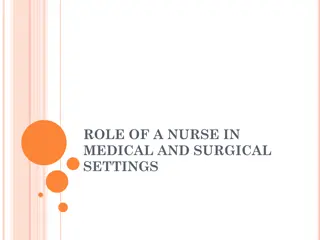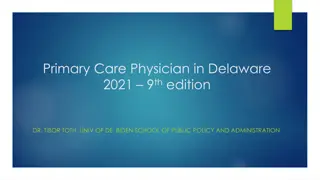Effective Training for Physicians and Care Providers in Discussing Life-Sustaining Treatments
This training program focuses on equipping physicians, advance practice nurses, and physician assistants with the essential communication skills needed to have effective goals of care conversations with patients. It covers discussing life-sustaining treatments such as artificial nutrition, hydration, mechanical ventilation, and CPR, while emphasizing the importance of aligning treatments with patient values and goals. It also addresses unintended consequences of certain medical interventions, aiming to ensure that patients receive care consistent with their individual preferences and priorities.
Download Presentation

Please find below an Image/Link to download the presentation.
The content on the website is provided AS IS for your information and personal use only. It may not be sold, licensed, or shared on other websites without obtaining consent from the author.If you encounter any issues during the download, it is possible that the publisher has removed the file from their server.
You are allowed to download the files provided on this website for personal or commercial use, subject to the condition that they are used lawfully. All files are the property of their respective owners.
The content on the website is provided AS IS for your information and personal use only. It may not be sold, licensed, or shared on other websites without obtaining consent from the author.
E N D
Presentation Transcript
Goals of Care Conversations Part 4 Discussing Life-Sustaining Treatments Training for Physicians, Advance Practice Nurses, and Physician Assistants Training for Physicians, Advance Practice Nurses, and Physician Assistants
Serious Illness Communication Skills Training Delivering Serious News Conducting Goals of Care Conversations Part 1 - Reframing: We re in a Different Place Part 2 - Mapping the Future: Clarifying Priorities Part 3 - Aligning with Patient Values Part 4 - Discussing Life-Sustaining Treatments
Life Life- -Sustaining Treatments Sustaining Treatments Artificial nutrition Artificial hydration Mechanical ventilation CPR Others, e.g., dialysis, blood products Transfers to the hospital, ICU
Successful Goals of Care Conversations SKILLS SKILLS KNOWLEDGE KNOWLEDGE Empathic Responses Responding to Challenging Questions See CPR Outcomes Patient Education Booklet Handouts
What are some unintended consequences of the following? Would you like us to try to restart restart your heart? Would you like us to do everything possible your father s heart stops beating and he stops breathing? everything possible if I think it s time to withdraw care withdraw care.
What are some unintended consequences of the following? Would you like us, in what would naturally be your final moments, to press on your chest and break your ribs, shove a tube down your throat and poke you with needles in lots of places in a chaotic attempt that has a very small chance of giving you more time to be technically alive but unlikely to ever return to meaningful communication with others? http://www.cunniffdixon.org/resource/do-not-punctuate-the-end-of-your-life-with-a-senseless-act-of-brutality-2/
Our role Ensure patients receive treatment consistent with their values and goals by helping them Define what is important to them Understand outcomes is the treatment likely to help them meet their goals? Make informed decisions
REMAP: Discussing Goals of Care REMAP: Discussing Goals of Care R Reassess understanding & R Reframe E Expect emotion M Map out what s important A Align with patient values P Plan treatment to match patient values
REMAP: Plan REMAP: Plan Treatments that Match Values Treatments that Match Values AFTER AFTER mapping what s important and aligning with the patient s values IF IF goals point to a clear plan about LST: Ask permission to make a recommendation Recommend treatments to support the patient s goals, what might be possible, and what not to do because it wouldn t support the patient s goals
What We Will Learn What to do AFTER AFTER mapping and aligning IF IF: The patient s goals do not point to clear plans/ recommendations regarding life-sustaining treatment (LST) The patient wants information about LSTs There appear to be inconsistencies between the patient s goals and LST decisions
Explore Preferences and Understanding Explore Preferences and Understanding IF IF the patient s goals don t point to a clear plan goals don t point to a clear plan for LST: We want to be sure you get the care that helps achieve what matters most to you. It s helpful to know in advance whether you would or wouldn t want certain procedures. As you think about your medical care, are there any treatments that you already know aren t acceptable to you?
Explore Knowledge Explore Knowledge When further exploration of the patient s preferences is needed: One treatment that would be helpful to talk about is [a ventilator] [a feeding tube] [CPR] [other.]. Can you tell me what you know about it?
Provide Information about the Treatment Provide Information about the Treatment Provide information in short gaps, giving the patient time to process and respond: short chunks to fill in knowledge CPR can be used when someone s heart and breathing stop. CPR involves forcefully pushing on the chest, and can include shocking the heart and putting a tube down the throat to try to get the heart and breathing to start again. A ventilator helps a person breathe when they can no longer breathe on their own. It involves a tube down the throat and a machine to push air into the lungs.
Explore Preferences for Additional Information Explore Preferences for Additional Information To explore what information would be helpful to the patient: Some people like to know the chances of living longer with a feeding tube, what the risks are, or what life might be like afterward. Other people have spiritual questions about these decisions. What about you? Do you prefer general information, or do you like to know numbers and averages?
Explore Possible Inconsistencies Explore Possible Inconsistencies IF IF the patient s decisions about LST seem inconsistent decisions about LST seem inconsistent with their stated goals with their stated goals: I worry that [a feeding tube] won t help you reach your goals. Tell me more about what you are hoping for with [CPR]. Is there a situation you could imagine when you would [or would not] want [a ventilator]?
Reviewing Goals & Decisions at a Later Date Reviewing Goals & Decisions at a Later Date After LST decisions have been made and documented, it may be appropriate to review them at a later date Review to confirm decisions without casting doubt With surrogates, start with what you know about the patient s goals and decisions NOTE: NOTE: When clinical circumstances have changed, use REMAP to explore goals before re-addressing decisions
Verifying Decisions Without Casting Doubt Verifying Decisions Without Casting Doubt When your mother met with Dr. Jones about two months ago, she knew her illness was getting worse, and she said it was her goal to stay as comfortable as possible. She wanted medical orders written so she wouldn t be put on a breathing machine or get CPR. Those orders are in place so everyone knows to honor her wishes. Is there anything more you can share to help us respect her decisions?
Drill Reminders Drill Reminders Drills include discussions about CPR; use the same steps to discuss any life-sustaining treatment Purpose: to practice specific skills, not represent a perfect discussion Use these skills AFTER mapping what is important to the patient
Drills Drills Drill A: Drill A: Transition into a discussion of life- sustaining treatment options when goals don t point to a clear recommendation Drill B: Drill B: Provide information about risks and outcomes Drill C: Drill C: Explore possible inconsistencies between the patient s goals and treatment decisions.
Drill Instructions Drill Instructions Review drill as a group Divide into pairs Practice Switch roles Debrief with one another: How did it feel to say the words? One thing you noticed as the clinician One thing you noticed as the patient
Drill A: Introduction Drill A: Introduction Clinician Patient I want to be sure you get the care that helps achieve what matters most to you. It s helpful to know in advance whether you would or wouldn t want certain procedures. Are there any treatments that you already know aren t acceptable to you? I m not sure. I haven t really thought about that.
Drill A: Perception / Invitation Drill A: Perception / Invitation Clinician Patient I ve seen it on TV, but I don t know much about it. I think it s used when people have a heart attack, but I m not sure. One treatment that we should talk about is CPR, or cardiopulmonary resuscitation. Can you tell me what you know about it? Sure. Would it be ok if I shared some information about it?
Drill A: Knowledge Drill A: Knowledge Clinician Patient CPR can be used when someone s heart and breathing stop. CPR involves forcefully pushing on the chest, and can also include shocking the heart and putting a tube down the throat to try to get the heart and breathing to start again. Wow, that sounds rough.
Drill A: Emotion / Knowledge Drill A: Emotion / Knowledge Clinician Patient I guess you don t really think about it when you see it on TV. A lot of people are surprised by that. Yeah, it s different to think about how CPR could affect you personally.
Drill Instructions: Swap Roles Drill Instructions: Swap Roles Patient Clinician
Debrief Debrief How did it feel to say the words? One thing you noticed as the clinician One thing you noticed as the patient
Drill B Drill B Drill B Drill B shows how to provide information in three ways: 1. General outcomes 2. Specific odds 3. Possible outcomes linked to the patient s goals With patients, use the strategy that matches their preference for With patients, use the strategy that matches their preference for information. information.
Drill B: Assess Type of Information the Patient Wants Drill B: Assess Type of Information the Patient Wants Patient Clinician Some people like to know the chances of surviving after CPR, or its risks, or what life might be like afterward. Other people have spiritual questions related to these decisions. What about you? I m not sure I know enough to make a decision.
Drill B: Strategy 1 Drill B: Strategy 1 Share General Outcomes Share General Outcomes Patient Clinician Unfortunately, most adults who receive CPR don t survive. Young and otherwise healthy people have better chances of surviving, and people with serious health problems have lower chances. Doesn t CPR usually work?
Drill B: Strategy 2 Drill B: Strategy 2 Share Specific Odds Share Specific Odds Patient Clinician If 100 people in the hospital received CPR, about 18 would survive to leave the hospital. That means 82 out of 100 people would die. These are averages. For people with health problems like yours, the chances of survival are [lower] [lower]*. *customize per patient s risk using general terms How many people survive after CPR? What are the odds that I d make it through?
Drill B: Strategy 3 Drill B: Strategy 3 Share Outcomes Linked to Goals Share Outcomes Linked to Goals Patient Clinician I m concerned that CPR wouldn t help you live the life you want. There s a high risk of broken ribs that would cause pain. If CPR worked to restart your heart, there s a [large chance] you d need more help and wouldn t be able to live at home. After CPR, you might need the support of a breathing machine to keep you alive. *customize per patient s risk using general terms I don t want to be in pain or end up stuck on machines. [large chance]*
Drill Instructions: Swap Roles Drill Instructions: Swap Roles Patient Clinician
Debrief Debrief How did it feel to say the words? One thing you noticed as the clinician One thing you noticed as the patient
Drill C Drill C Drill C Drill C show how to explore possible inconsistencies between the patient s goals and treatment decisions. Use after thoroughly mapping the patient s goals and values.
Drill C: Recommend a Plan Based on Patients Goals Drill C: Recommend a Plan Based on Patient s Goals Clinician Patient I think I would still want to try CPR if my heart stops. Since it s really important to you to be independent and take care of yourself, I would not recommend CPR if your heart stops. Even if it worked to restart your heart, I worry that you wouldn t be able to get off the machines afterward, or if you did, you would be too weak to take care of yourself or go home again.
Drill C: Explore Possible Inconsistencies Drill C: Explore Possible Inconsistencies Clinician Patient When it comes right down to it, if there s any chance I d get another day with my family, it would be worth it, even if I ended up in pain or in the hospital on machines for a while. I know it might not work, and I might be in terrible shape, but I d want to give it a try. Tell me what you re hoping for with CPR.
Drill C: Explore Limits Drill C: Explore Limits Clinician Patient I can see how important your family is to you, and I really respect that. Can you think of a situation when you wouldn t want CPR? I want to give CPR a chance. But if you try it and I end up with brain damage, don t try it again.
Drill C: Explore Limits Drill C: Explore Limits Clinician Patient Tell me what you mean when you say, brain damage. If I get CPR, and afterward I m not able to take care of myself or make my own decisions, then I wouldn t want CPR again. I don t want to be a burden on my family. Ok. What if you develop those problems before CPR? Then I wouldn t want it.
Drill C: Summarize Drill C: Summarize Clinician Patient At this point, you would want an attempt at CPR if your heart and breathing stop. If you were ever permanently unable to take care of yourself or make your own decisions, you wouldn t want CPR. Do I have that right? Yes, that s right.
Drill C: Next Steps Drill C: Next Steps Clinician Patient That s a good idea. She might have some questions, and I want her to know what I want. Thanks for helping me understand what you want. Your daughter should know about this, too, since you chose her to communicate your decisions if you can t speak for yourself. Can you bring her with you to your next appointment?
Drill C: Next Steps Drill C: Next Steps Patient Clinician
Debrief Debrief How did it feel to say the words? One thing you noticed as the clinician One thing you noticed as the patient
Summary: Discussing LST Summary: Discussing LST If goals point to a clear LST plan If goals point to a clear LST plan, ask permission and make a recommendation If goals don t point to a clear LST plan If goals don t point to a clear LST plan: Ask permission to talk about treatments the patient may or may not want Assess understanding of the treatment Asses information the patient wants and provide it Explore decisions that do not appear to match goals Explore decisions that do not appear to match goals
Goals of Care Conversations: REMAP Reassess understanding & Reframe Expect emotion Map out what s important Align with patient values Plan treatment to match patient values What surprised you? What do you want to take forward? Anywhere you might get stuck? What s one thing you will try in the next two weeks?
Goals of Care Conversations Goals of Care Conversations training materials were developed and made available for public use through U.S. Department of Veterans Affairs contracts with VitalTalk [Orders VA777-14-P-0400 and VA777-16-C-0015]. Materials are available for download from VA National Center for Ethics in Health Care at www.ethics.va.gov/goalsofcaretraining.asp. Published Jan. 2017























